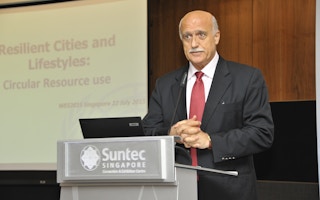From prolonged droughts in Bangkok to unprecedented rainstorms in Tokyo, cities globally have had to deal with the damaging effects of climate change. Yet many of them still lack the systems and policies that make them resilient.
To continue reading, subscribe to Eco‑Business.
There's something for everyone. We offer a range of subscription plans.
- Access our stories and receive our Insights Weekly newsletter with the free EB Member plan.
- Unlock unlimited access to our content and archive with EB Circle.
- Publish your content with EB Premium.
Speaking at the World Engineers Summit on Climate Change 2015 last Wednesday, Dr Arab Hoballah, chief of the sustainable consumption and production branch, division of technology, industry and economics at the United Nations Environment Programme, said that cities today are still not climate-resilient because they do not have the “boing” factor – a term first coined by Neil McInroy and Sarah Longlands in their 2010 publication Productive Local Economies: Creating Resilient Places.
The “boing” factor, much like the sound made from the release of a compressed spring, refers to the ability of cities to not only absorb and manage the shocks of environmental disasters but also proactively take advantage of those shocks to improve its crisis management systems.
According to McInroy and Longlands, climate-resilient cities which possess the “boing” factor will be better able to cope with and endure the damaging impacts of climate change in the long-run.
Moving towards a circular economy
To cultivate climate resilience, Dr Hoballah suggested that cities work towards creating a circular economy through a systems-based approach.
This means that more attention should be placed on understanding how efficiently we consume and produce goods and services within the economy.
According to Dr Hoballah, the world’s limited resources means that cities need to adopt a circular economy model where waste can be reused, repaired or refurbished in order to re-enter the production process.
This presents a departure from the linear “take, make, consume and dispose” model and pushes cities to think of long-term sustainable strategies in managing resources. Developing production systems which are efficient and yet flexible enough to adapt and respond to climate change is essential to the “boing” factor, Dr Hoballah said.
Sustainable development in cities
By 2050, cities will account for 80 per cent of global economic growth. They will also be responsible for at least 75 per cent of the world’s greenhouse gas emissions and waste output.
As the world’s population becomes increasingly urban, Dr Hoballah noted that it is crucial for sustainable development to occur at the city level.
“Cities should become the dynamic hubs toward an integrated approach to environmental, social and economic sustainability, in particular by driving local and national development while increasing efficiency and reducing impact on the environment,” he said.
He described the method of achieving economic growth while reducing environmental impact as decoupling – a process which he said should be spearheaded by engineers who are best equipped with the knowledge and tools to build efficient systems in cities.
“
Cities should become the dynamic hubs toward an integrated approach to environmental, social and economic sustainability, in particular by driving local and national development while increasing efficiency and reducing impact on the environment.
Dr Arab Hoballah, chief of the sustainable consumption and production branch, division of technology, industry and economics at the UN Environment Programme
Engineers can pave the way
Engineers have a role in changing the way consumers and businesses use resources in a circular economy, Dr Hoballah stated. With the rapid rise of middle-class consumers especially in Asia and Africa, a change in current consumer lifestyles is critical.
New engineering innovations also allow lawmakers to better appreciate interactions within the economy. The more we understand our “import” of resources, the more we can implement the appropriate policies to limit or reduce the “export” of emissions, Dr Hoballah stressed.
Using popular green building initiatives across the world as an example, Dr Hoballah stated that engineers need to work with policymakers to scale up green technologies and make them easily available to all buildings in cities.
During the same technical track session at the World Engineers Summit 2015, Mrs Lim Hwee Hua, executive director of Singapore-based private equity investment firm Tembusu Partners, also shared her thoughts on how the government can shape climate change aspirations.
In her opening keynote address, Mrs Lim noted that countries need to take a “whole of government” approach in tackling climate change and environmental pollution. This means that lawmakers and the government need to play a key role in formulating the policy framework and coordinating actions between its various ministries as well as NGOs and the private sector.
Dr Hoballah agreed that all stakeholders have a part to play in effecting climate change policies.
“Legislation is necessary but it is not the end. The law needs to be understood and applied,” he said. “And it will only be understood and applied if it is not created solely by the government - it has to involve the economists, engineers and private sector. Otherwise, the legislation will be stuck on the shelf or implemented wrongly.”










